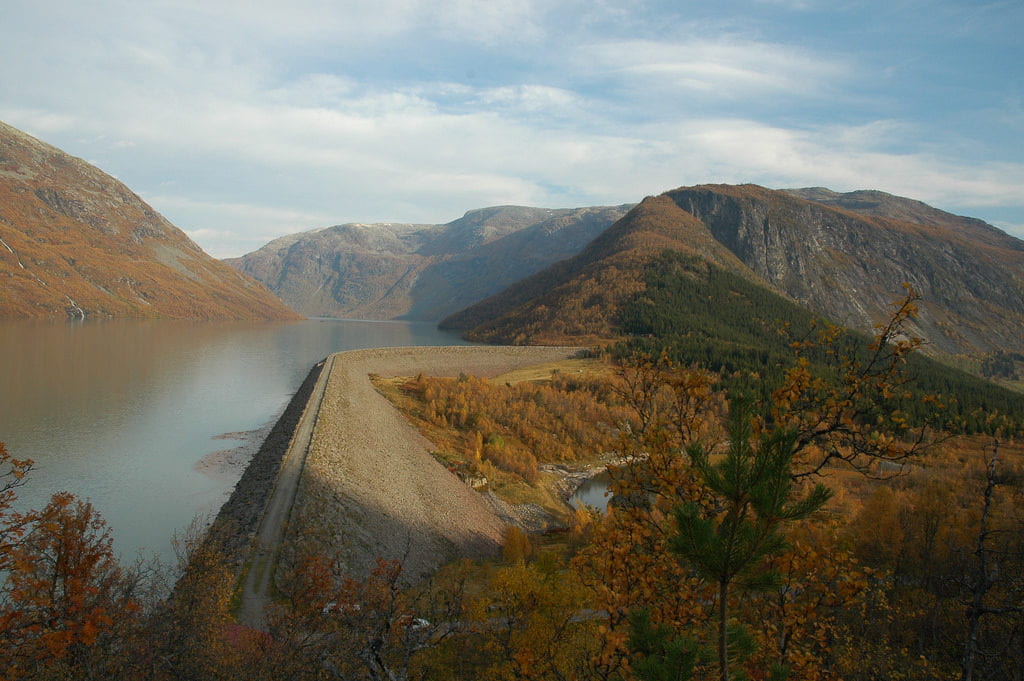by Karen Marie Oseland
This article was originally published in The Norwegian American.

Large dams like this one at Tunsbergdalsvatn look impressive, but today most of Norway’s new projects are smaller modifications that are easier on the environment.
The oversupply of oil in the world market, maturing oilfields, and the low price environment are some of the economic challenges that Norway is currently facing. In order to overcome them, Norway needs to diversify its economy. The nation has the potential to become a major exporter of electricity from hydropower.
This is becoming a real possibility because of three main factors: increased water flow in Norway, Europe’s need for energy, and current construction of the infrastructure needed. In order to achieve this goal, the Norwegian government and Statkraft [a Norwegian state-owned power producer] need to develop long-term policies and continue to reassure people of the benefits of hydropower and the measures being taken to decrease environmental impact.
Because of climate change, Norway is experiencing a warmer and wetter climate. The annual water run-off to hydropower reservoirs in the country has the potential to increase up to 11 percent during the 21st century. This allows for the generation of more surplus electricity that can be exported. Norway can add 20 GW of pumped hydro storage to Europe in just a couple of years. This is equivalent to the amount of electricity generated from 20 to 40 coal plants. It will definitely generate a lot of revenue to the country, and secondly, it will help Norway reach its 2030 goal of cutting greenhouse gas emissions by 40%.
While Norway has excess electricity to export, Europe also has the need for it. Because high temperatures and drought decrease the performance of European nuclear, gas, and coal power plants, it is absolutely crucial that Norway steps in with its excess hydro production to make up for these problems. Also, European countries like Germany, France, and Spain are trying to transition away from fossil fuels, and Norway will be able to help countries do so. Finally, Russia has become an unstable energy actor due to the situation in Ukraine and Eastern Europe. Germany, Ukraine, and other countries that buy power from Russia cannot be held hostage to such an unpredictable trading partner. These countries need a country like Norway to establish reliable and clean energy flow.
Norway’s push for exporting electricity from hydropower could lead to the European Supergrid finally becoming a reality. A coalition of companies like ABB, Alstom, General Electric, and Siemens have envisioned a European grid that would be a single market high-voltage electricity network delivering power from facilities like Norwegian hydropower dams, Spanish solar farms, and North Sea wind farms to wherever it is needed. This would allow for the wider use of renewable energy, and if fossil fuels are limited or prohibited, it could help us limit atmospheric warming to 2 degrees Celsius.
Norway already has much of the infrastructure needed to export excess electricity from hydropower to Europe. It already exports hydropower to the Netherlands, Sweden, Denmark, and Finland using six high-voltage direct current interconnections that run from Norway to the four countries.
New infrastructure is also planned between Norway and Germany, and Norway and the United Kingdom. The two power cables will enter commercial operation in 2020 and 2021 and have a capacity of 1.4 GW. At completion, the Norway-UK interconnection will be 720 km long. This will be the longest subsea power interconnection in the world. Additional such power cables should also be considered to further expand Europe’s access to Norwegian hydropower electricity.
In addition, the Norwegian government and Statkraft must continue to reassure people of the benefits of hydropower. Hydropower is an excellent source of energy as it is clean, has high capacity factors, and has the lowest production cost in the country. Hydropower plants can be operated for 50 to 100 years. Norway has vast potential with its over 130 years of technological experience, its geography, and its 1,393 currently operating hydropower plants.
Measures are being taken to decrease the environmental impact of hydropower plants. Currently, Norway focuses more on smaller plants that do not require the building of large dams and are considered more environmentally friendly. Norway should therefore continue to build these small plants, and add capacity at existing hydropower plants, or even build hydropower facilities at existing dams. Modifying has less impact on the environment than building new plants.
Although Norway today faces tough economic challenges, it has huge potential for growth. With further investment in hydropower and improved polices, Norway can export its energy to the rest of Europe.
Karen Marie Oseland is a Norwegian graduate student from Stavanger, Norway. She is currently enrolled in a master’s program in Global Affairs at the School of Professional Studies at New York University where she specializes in Energy and Environment Policy.
